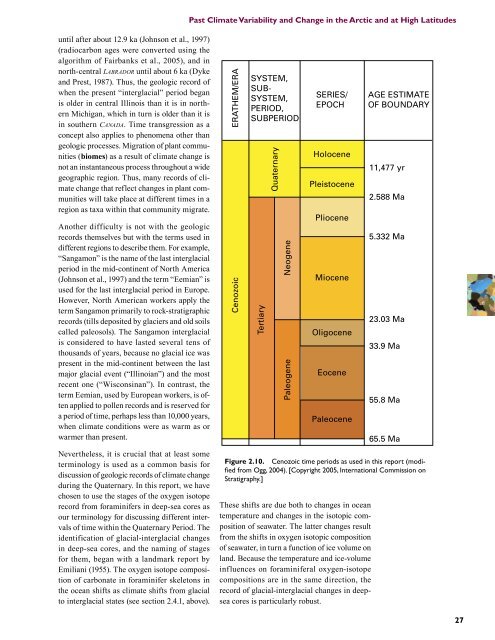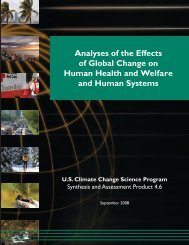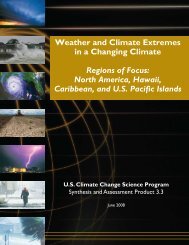Past Climate Variability and Change in the Arctic and at High Latitudes
Past Climate Variability and Change in the Arctic and at High Latitudes
Past Climate Variability and Change in the Arctic and at High Latitudes
You also want an ePaper? Increase the reach of your titles
YUMPU automatically turns print PDFs into web optimized ePapers that Google loves.
until after about 12.9 ka (Johnson et al., 1997)<br />
(radiocarbon ages were converted us<strong>in</strong>g <strong>the</strong><br />
algorithm of Fairbanks et al., 2005), <strong>and</strong> <strong>in</strong><br />
north-central lAbrAdor until about 6 ka (Dyke<br />
<strong>and</strong> Prest, 1987). Thus, <strong>the</strong> geologic record of<br />
when <strong>the</strong> present “<strong>in</strong>terglacial” period began<br />
is older <strong>in</strong> central Ill<strong>in</strong>ois than it is <strong>in</strong> nor<strong>the</strong>rn<br />
Michigan, which <strong>in</strong> turn is older than it is<br />
<strong>in</strong> sou<strong>the</strong>rn cAnAdA. Time transgression as a<br />
concept also applies to phenomena o<strong>the</strong>r than<br />
geologic processes. Migr<strong>at</strong>ion of plant communities<br />
(biomes) as a result of clim<strong>at</strong>e change is<br />
not an <strong>in</strong>stantaneous process throughout a wide<br />
geographic region. Thus, many records of clim<strong>at</strong>e<br />
change th<strong>at</strong> reflect changes <strong>in</strong> plant communities<br />
will take place <strong>at</strong> different times <strong>in</strong> a<br />
region as taxa with<strong>in</strong> th<strong>at</strong> community migr<strong>at</strong>e.<br />
Ano<strong>the</strong>r difficulty is not with <strong>the</strong> geologic<br />
records <strong>the</strong>mselves but with <strong>the</strong> terms used <strong>in</strong><br />
different regions to describe <strong>the</strong>m. For example,<br />
“Sangamon” is <strong>the</strong> name of <strong>the</strong> last <strong>in</strong>terglacial<br />
period <strong>in</strong> <strong>the</strong> mid-cont<strong>in</strong>ent of North America<br />
(Johnson et al., 1997) <strong>and</strong> <strong>the</strong> term “Eemian” is<br />
used for <strong>the</strong> last <strong>in</strong>terglacial period <strong>in</strong> Europe.<br />
However, North American workers apply <strong>the</strong><br />
term Sangamon primarily to rock-str<strong>at</strong>igraphic<br />
records (tills deposited by glaciers <strong>and</strong> old soils<br />
called paleosols). The Sangamon <strong>in</strong>terglacial<br />
is considered to have lasted several tens of<br />
thous<strong>and</strong>s of years, because no glacial ice was<br />
present <strong>in</strong> <strong>the</strong> mid-cont<strong>in</strong>ent between <strong>the</strong> last<br />
major glacial event (“Ill<strong>in</strong>oian”) <strong>and</strong> <strong>the</strong> most<br />
recent one (“Wiscons<strong>in</strong>an”). In contrast, <strong>the</strong><br />
term Eemian, used by European workers, is often<br />
applied to pollen records <strong>and</strong> is reserved for<br />
a period of time, perhaps less than 10,000 years,<br />
when clim<strong>at</strong>e conditions were as warm as or<br />
warmer than present.<br />
Never<strong>the</strong>less, it is crucial th<strong>at</strong> <strong>at</strong> least some<br />
term<strong>in</strong>ology is used as a common basis for<br />
discussion of geologic records of clim<strong>at</strong>e change<br />
dur<strong>in</strong>g <strong>the</strong> Qu<strong>at</strong>ernary. In this report, we have<br />
chosen to use <strong>the</strong> stages of <strong>the</strong> oxygen isotope<br />
record from foram<strong>in</strong>ifers <strong>in</strong> deep-sea cores as<br />
our term<strong>in</strong>ology for discuss<strong>in</strong>g different <strong>in</strong>tervals<br />
of time with<strong>in</strong> <strong>the</strong> Qu<strong>at</strong>ernary Period. The<br />
identific<strong>at</strong>ion of glacial-<strong>in</strong>terglacial changes<br />
<strong>in</strong> deep-sea cores, <strong>and</strong> <strong>the</strong> nam<strong>in</strong>g of stages<br />
for <strong>the</strong>m, began with a l<strong>and</strong>mark report by<br />
Emiliani (1955). The oxygen isotope composition<br />
of carbon<strong>at</strong>e <strong>in</strong> foram<strong>in</strong>ifer skeletons <strong>in</strong><br />
<strong>the</strong> ocean shifts as clim<strong>at</strong>e shifts from glacial<br />
to <strong>in</strong>terglacial st<strong>at</strong>es (see section 2.4.1, above).<br />
<strong>Past</strong> <strong>Clim<strong>at</strong>e</strong> <strong>Variability</strong> <strong>and</strong> <strong>Change</strong> <strong>in</strong> <strong>the</strong> <strong>Arctic</strong> <strong>and</strong> <strong>at</strong> <strong>High</strong> L<strong>at</strong>itudes<br />
ERATHEM/ERA<br />
Cenozoic<br />
SYSTEM,<br />
SUB-<br />
SYSTEM,<br />
PERIOD,<br />
SUBPERIOD<br />
Tertiary<br />
Qu<strong>at</strong>ernary<br />
Neogene<br />
Paleogene<br />
SERIES/<br />
EPOCH<br />
Holocene<br />
Pleistocene<br />
Pliocene<br />
Miocene<br />
Oligocene<br />
Eocene<br />
Paleocene<br />
AGE ESTIMATE<br />
OF BOUNDARY<br />
11,477 yr<br />
2.588 Ma<br />
5.332 Ma<br />
23.03 Ma<br />
33.9 Ma<br />
55.8 Ma<br />
65.5 Ma<br />
Figure 2.10. Cenozoic time periods as used <strong>in</strong> this report (modified<br />
from Ogg, 2004). [Copyright 2005, Intern<strong>at</strong>ional Commission on<br />
Str<strong>at</strong>igraphy.]<br />
These shifts are due both to changes <strong>in</strong> ocean<br />
temper<strong>at</strong>ure <strong>and</strong> changes <strong>in</strong> <strong>the</strong> isotopic composition<br />
of seaw<strong>at</strong>er. The l<strong>at</strong>ter changes result<br />
from <strong>the</strong> shifts <strong>in</strong> oxygen isotopic composition<br />
of seaw<strong>at</strong>er, <strong>in</strong> turn a function of ice volume on<br />
l<strong>and</strong>. Because <strong>the</strong> temper<strong>at</strong>ure <strong>and</strong> ice-volume<br />
<strong>in</strong>fluences on foram<strong>in</strong>iferal oxygen-isotope<br />
compositions are <strong>in</strong> <strong>the</strong> same direction, <strong>the</strong><br />
record of glacial-<strong>in</strong>terglacial changes <strong>in</strong> deepsea<br />
cores is particularly robust.<br />
27




